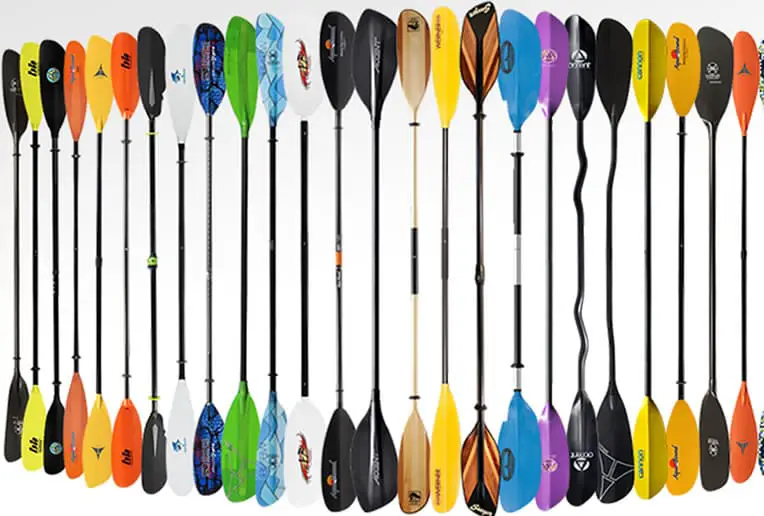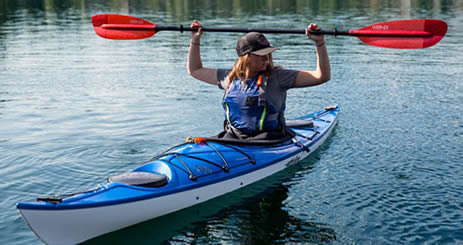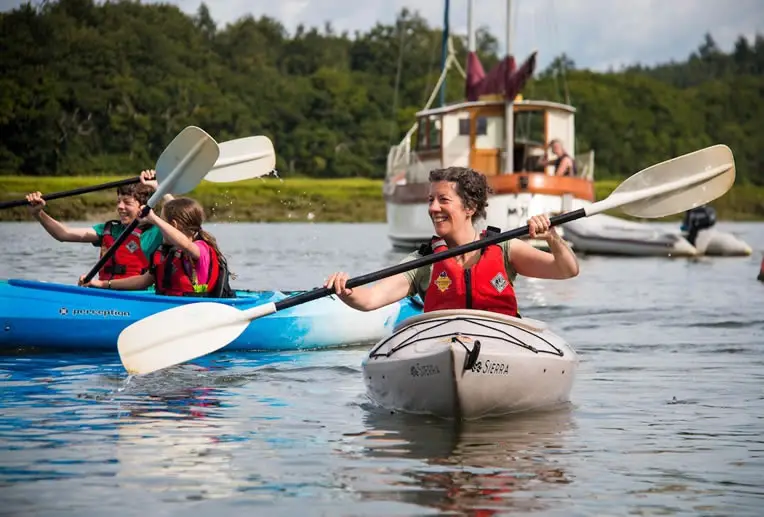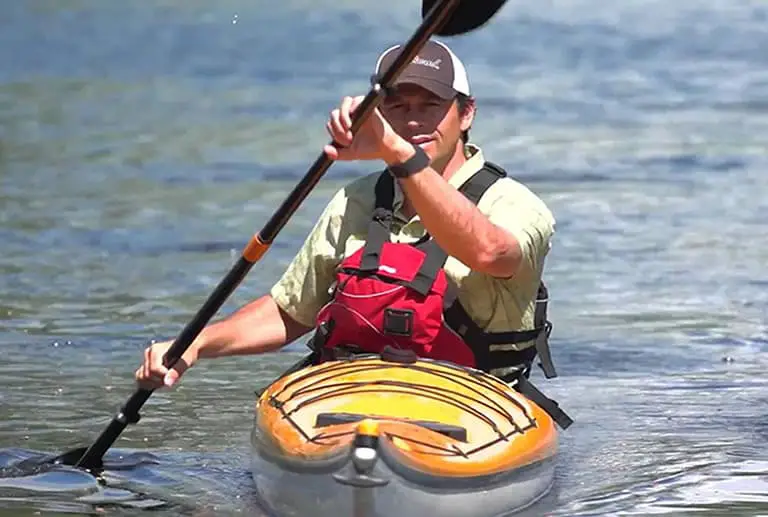Why does my kayak not go straight?
When you cannot keep your kayak moving in straight it is probably due to one or more of the following reasons:
- You are not applying proper body posture when paddling the kayak.
- You are not holding your paddle correctly.
- You are not executing the right paddle strokes.
All of these problems are easily solved when you execute the correct paddling techniques.
Correct techniques for keeping your kayak straight
Here I teach you the techniques for gliding your kayak across the water in a straight line.
I also include information on the correct safety procedures to keep in mind while doing.

So, please read on.
Proper body posture is essential when paddling
The shape of a kayak is narrow and novice paddlers will find that it is likely to tip sideways before they move forward.
To avoid this, you need to make sure that your body is in the right position to balance the kayak.
To do this maintain your body in an upright position while relaxing your shoulders and your stomach.
Your eyes should focus on the horizon as this helps to keep your stability. If there is a current, let the waves push your kayak freely as you start to move your blade.
If you find that you only experience problems moving in a straight line in a current then read this article which outlines how to paddle against the current.
It is worth mentioning that any little movement can rock your boat from side to side, so avoid putting pressure on one side of the kayak when moving.
Bending your legs slightly will give you extra balance.
Make sure that your feet are constantly pressed against the foot pegs without your torso leaning on the backrest of the kayak.
This allows your upper body to rotate better, giving your arms the freedom to paddle efficiently.
Make sure that your shoulders and arms are ready to give extra support while your upper body and legs do most of the work.
If you lose balance, you can always use the paddle to swiftly smack the water to stabilize your kayak.
Your body and the kayak will move in sync and with efficiency when you maintain proper posture.
Good posture is an important aspect of kayaking and so it is a good idea to stay aware of your posture, correcting poor posture as you become aware of it, until good posture becomes a habit.
But posture is only half of the story.
You also need to apply the proper paddling techniques.
It all starts with the paddle
Use the type of paddle blades that match your needs.
There are three main blade types:
- Feather blades
- Asymmetrical blades
- Curved blades.
Feather blades are more common and tend to be easier to use for beginners.

Asymmetrical blades can help the paddler track straight as he pulls the paddle and kayak through the water.
Curved blades grab more water to create more powerful stroke.
So which blade is better for keeping your kayak moving in a straight line?
The ideal paddle for those trying to steer their boat straight are feather blades.
These blades reduce wind resistance, thus giving more momentum for the kayak to thrust forward.
As you gain more experience on the water and develop your paddling skills, you will want to try other types of paddles as well to see which one is a better fit for your paddling style and kayaking needs.
Proper paddle technique
If correct your posture but still find that your kayak will not track straight then you have a poor paddling technique.
Correct paddling technique is a learned skill but the good news is that it is easy to learn.
Let’s take a look at how to improve your technique so you have more control over your kayak.
How to hold your paddle correctly
Efficient and correct paddling is the key to making your kayak go in a straight line.
Proper paddling technique begins with knowing how to hold your paddle correctly.
The position of your grip and the strength of your arms are significant factors in creating sufficient motion to thrust your boat forward.
You can use a number of the helpful tips below to help you develop an efficient and correct paddling technique.
Knowing where to grip the shaft is important. Ideally, your elbows should be at a 90-degree angle while gripping the shaft.
Doing this makes your arms and the paddle look like a box, commonly referred to as the “the paddler’s box.”

This box should guide your body while paddling.
If you are a beginner, you may notice that it is hard to maintain the box position of your arms and paddle in the beginning.
Remember that you can always slow down and practice paddling while keeping an eye on your posture.
Keep your dominant hand in check
Do not let your dominant hand be, well, dominant. Let me explain that statement.
If you are right-handed, you may notice that when you paddle, the natural strength from your right arm can cause your kayak to veer off to the right and away from a straight track.
In this case, you can always put equal strength into your left stroke to maintain a linear glide of your boat.
This takes conscious effort at first but you will find after a short while it becomes an automatic way of paddling for you.
Find balance in your grip and stroke.
To help you paddle the kayak in a linear motion, it is important that you find a balance in gripping and stroking your paddle.
Maintaining your paddler’s box while executing different stroke styles can sometimes be tiresome, especially if you are kayaking throughout the day.
Every so often, you should relax your grip and rely on your torso to power your paddle.
Keep in mind that learning to paddle effectively will take a little time.
Structure your initial kayak trips so you can set your own pace and go as slowly as you need to in order to properly practice your techniques.
By doing so, you will also avoid developing injuries.
Why your kayak pulls to the left or right
There are a few reason your kayak may be pulling to one side or even spinning.
Main causes of pulling to left, right or spinning:
- Your dominant hand has a stronger paddle stroke.
- You have poor body posture.
- You are pushing down too hard on one of the footrests.
Your dominant hand dictates the direction of your boat. If you are right-handed, it is likely that you will keep veering to the left.
If you are left-handed it is likely you will be veering to the right.
This can be frustrating, so slow your pace and practice giving equal force from both your arms.
Another reason why your kayak pulls to the left or right is the weight generated by your movement.
As we have mentioned above, even the slightest movement can affect how your kayak turns and may even tip it over.

So, try to avoid adjusting your body often while paddling.
To keep your kayak from swerving left or right, maintain proper body posture and generate only enough power from both your arms while stroking.
Also be aware that pushing down on one of the footrests more than the other, while paddling, can also cause the kayak to pull slightly to one side.
Forward stroke to stop your kayak from turning
Holding your paddle correctly is just one part of the equation for keeping your kayak moving in a straight line.
Determining the appropriate paddle stroke is just as important.
There are a lot of paddle strokes used by different kayakers to achieve different aims. Each has it owns purpose.
However, let us focus on one significant stroke that will help you keep your kayak moving in a straight line.
Forward stroke is the most common and suitable for steering your kayak in a linear direction.
To perfect the technique, you must practice the stroke repeatedly and in a diligent, conscious way.
Basically, there are three ways to execute the stroke. They are:
- Catch the water.
- Propel forward.
- Release the water.
Let’s look at these techniques now.
Catch the water.
You need to gather the strength of your paddle using your feet.
Remember that bending your legs and pushing your feet against the foot pegs not only helps in balancing your boat but also gives power to your paddle.
Just be aware not to put too much force on one of the footrests.
Keep the pressure even on both sides.
After planting your lower body against the peg, rotate your torso; the blade then catches the water, starting the momentum of your kayak.
Propel forward.
Pull the paddle back to the side of your hip, then you can see the water slices up cleanly.
Release the water.
As your paddle reaches the side of your hip, release the water by pulling the blade out.
These three phases create a powerful momentum that thrusts your boat forward.
Remember to maintain your torso in an upright position, and in turn, you will keep your balance and gain more control.
Also keep in mind that your arms, core and legs are fully engaged in this movement.
Do this repeatedly as you navigate your kayak in a straight direction.
There may be more techniques to keep your kayak in a linear motion.
But maintaining proper body posture and incorporating correct paddle movements surely are the most important ones.
You may get fatigued quickly if you are not observing the proper technique.
So, whether you are a beginner or an intermediate kayaker, you can always revisit the techniques we have discussed in this article to help improve your experience on the water.

